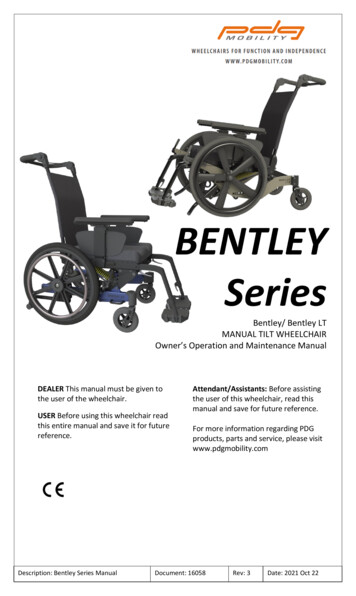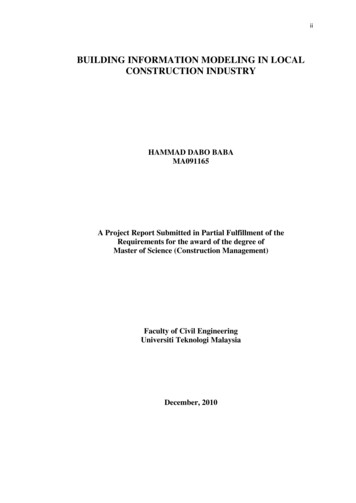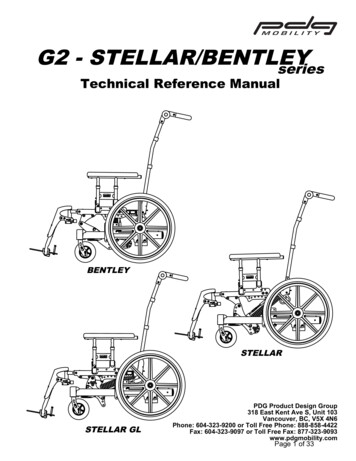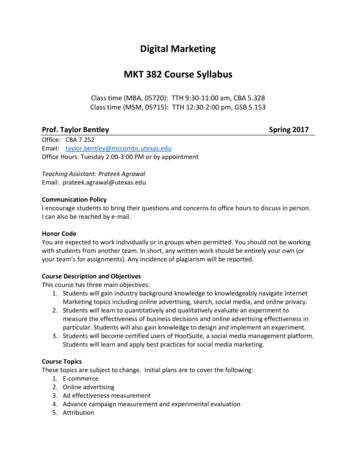
Transcription
BENTLEYSeriesBentley/ Bentley LTMANUAL TILT WHEELCHAIROwner’s Operation and Maintenance ManualDEALER This manual must be given tothe user of the wheelchair.USER Before using this wheelchair readthis entire manual and save it for futurereference.Description: Bentley Series ManualAttendant/Assistants: Before assistingthe user of this wheelchair, read thismanual and save for future reference.For more information regarding PDGproducts, parts and service, please visitwww.pdgmobility.comDocument: 16058Rev: 3Date: 2021 Oct 22
PAGE 21 INTRODUCTIONThank you for purchasing a PDG mobility wheelchair.Please do not operate this equipment without first reading and understanding thismanual. If you are unable to understand the warnings and instructions, contact a healthcare professional such as an Assistive Technology Practitioner (ATP), clinical professionalor therapist who is familiar with this type of product before attempting to use thisequipment.If you have any questions or comments about this manual, the safety and reliability ofyour wheelchair and the service you receive by us or your PDG supplier, please write orcall us using the contact information below:PDG PRODUCT DESIGN GROUP INC.#103- 318 East Kent Avenue South, Vancouver, BC V5X 4N6Ph: (604) 323-9220 Fax: (604) 323-9097E-mail: info@pdgmobility.comPlease note and reference your product serial number when contacting PDG for us tobetter serve your customer support needs.Serial Number:SAVE THIS MANUAL FOR FUTURE REFERENCEClass 1 MedicalRev. 2
PAGE 32 TABLE OF CONTENTS1INTRODUCTION . 22TABLE OF CONTENTS . 33NOTICE – READ BEFORE USE . 54SAFETY SUMMARY . 65SAFETY AND HANDLING OF WHEELCHAIRS . 75.1Stability and Balance . 85.2Tilting . 85.3Curbs and Steps . 95.4Stairways and Escalators . 115.5Transfers to and from Other Seats . 115.6Weight Distribution. 125.7Reaching, Leaning, and Bending Forward. 126ENVIRONMENTAL CONDITIONS . 137STANDARD FEATURES (BENTLEY & BENTLEY LT) . 148STANDARD FEATURES (BENTLEY LT-R) . 159UNPACKING AND ASSEMBLY. 169.1Inspection. 169.2Out of the Box Assembly Instructions. 1610 STORAGE . 1711 SAFETY INSPECTION CHECKLIST . 1712 MAINTENANCE . 1912.1Cleaning . 1912.2Suggested Maintenance Procedures . 1913 TROUBLESHOOTING . 1914 DAMAGE REQUIRING SERVICE BY QUALIFIED SERVICE AGENT . 2015 SETUP, ADJUSTMENTS & OPTIONS . 2015.1Adjustment Guide . 2015.2Frame Options (and Identification). 2115.3Seat Depth . 2215.4Seat-To-Floor Height . 2315.5Armrests . 2515.6Front Rigging . 2715.7Footplates . 3115.8Backrest Adjustments and Options. 3215.9Rear Wheels (Front Wheels for Reverse Bentley LT-R) . 3415.10Rear Anti-Tippers . 3815.11Front Anti tippers (Reverse Bentley LT-R). 3815.12Casters. 39Class 1 MedicalRev. 2
PAGE 415.13Wheel-Locks . 3915.14Seat Tilt . 4115.15Gas Strut and Cable Assembly . 4315.16Heel Loops (Optional) . 4415.17Padded Calf Strap (Optional) . 4415.18Headrest (Optional) . 4415.19Postural Support Devices or Lap Belts (Optional) . 4515.20Oxygen (O2) Tank Holder (Optional) . 4515.21IV (Intravenous) Pole Mount (Optional) . 4615.22Extended Base with Rear Floor Jacks (Optional) . 4615.23Motor Vehicle and Transit Use . 4616 ISO 7176-15 TEST INFORMATION DISCLOSURE . 4917 LIMITED WARRANTY . 50Class 1 MedicalRev. 2
PAGE 53 NOTICE – READ BEFORE USEAs a manufacturer of wheelchairs, PDG endeavors to supply a wide variety ofwheelchairs to meet the many needs of the end user. However, final selections of thetype of wheelchair to be used by an individual rests solely with the user and his/herhealthcare professional capable of making such a selection. Thus it is recommend anAssistive Technology Professional, clinical professional or therapist be consulted todetermined which model would best meet the wheelchair user’s mobility andpositioning needs.All wheelchair set-up and adjustments must be performed by a qualified technician.The options you choose and the set-up and adjustments have a direct impact on thewheelchairs stability. Factors to consider that affect your safety and stability are:a. User’s abilities and capabilities specifically of strength, balance andcoordination.b. The types of daily hazards and obstacles encountered.c. The specific dimensions, options and set up of the wheelchair. In particularany changes to the seat height, seat depth, seat angle, back angle, size andposition of the rear wheels and front casters will change the stability of yourwheelchair. You should only make changes after consulting with a qualifiedprofessional.WARNING and CAUTION notices as used in this manual apply to hazards or unsafepractices, which could result in personal injury or property damage.NOTE – THE INFORMATION CONTAINED IN THIS DOCUMENT IS SUBJECT TO CHANGEWITHOUT NOTICE. An updated version of this owner’s manual may be available atwww.PDGMobility.comINDICATIONS FOR USE – The Bentley Manual Tilt Wheelchair is intended to providemobility to persons restricted to a seated position.CONTRAINDICATIONS: Does not have the required ability to adequately manage the functions of amanual tilt-in-space wheelchair and does not have a capable caregiver for therequired assistance Cannot tolerate prolonged periods in a seated position with posterior tilt Highly agitated occupantsWHEELCHAIR TIE-DOWN RESTRAINTS AND SEAT RESTRAINTS – PDG does notrecommend wheelchair users be transported in vehicles of any kind while inwheelchairs. Wheelchair users should transfer to the vehicle seat and use the vehiclemanufacturer-installed restraint systems whenever it is feasible, and the unoccupiedwheelchair should be stored in a cargo area or secured in the vehicle during travel.However, if transportation in a vehicle in the wheelchair is required, the wheelchairmust be equipped with PDG factory installed transport-ready tiedown mounting pointsand the wheelchair occupant must use a restraint device. The Bentley wheelchaircomplies with the crash testing requirements of ISO 7176-19: 2008 and, as such, hasbeen designed and tested for use as a forward-facing seat in motor vehicle. Thus, fortransportation in a vehicle the wheelchair must be restrained from movement usingRESNA WC-4:2017, section 18 wheelchair tie-down system and the vehicle must beequipped with RESNA WC-4:2017, section 19 anchor points.Class 1 MedicalRev. 2
PAGE 6POSITIONING STRAPS and SEAT BELTS - IT IS THE OBLIGATION OF THE HOME DEALER,THERAPISTS AND OTHER HEALTH CARE PROFESSIONALS TO DETERMINE IF APOSITIONING DEVICE IS REQUIRED TO ENSURE THE SAFE OPERATION OF THISEQUIPMENT BY THE USER. SERIOUS INJURY CAN OCCUR IN THE EVENT OF A FALLFROM A WHEELCHAIR.4 SAFETY SUMMARYOperating Information WarningUnless otherwise noted, all service and adjustments should be performed while thewheelchair is unoccupied.To determine and establish particular safety limits, practice bending, reaching andtransferring activities in several combinations in the presence of a qualified healthprofessional BEFORE attempting active use of the wheelchair. The necessary back angle MUST be selected BEFORE repositioning the rear wheelsforward. DO NOT operate the tilt function if the trigger release levers and cables are notproperly adjusted. Ensure that the tilt function is locked in place when the triggeris released. DO NOT traverse, climb or go down ramps or slopes greater than 9 . DO NOT leave the occupied wheelchair unattended at any time, especially on anincline. DO NOT attempt to reach objects if you have to move forward in the seat. DO NOT attempt to reach objects if you have to pick them up from the floor byreaching down between your knees. DO NOT lean over the top of the back upholstery to reach objects from behind asthis may cause the wheelchair to tip. DO NOT shift weight or sitting position toward the direction of reach as thewheelchair may tip. DO NOT tip the wheelchair about the rear wheel without assistance. DO NOT use an escalator to move a wheelchair between floors. Serious bodilyinjury may occur. DO NOT attempt to stop a moving wheelchair with the wheel locks. WHEELLOCKS ARE NOT BRAKES. Before attempting to transfer in or out of wheelchair, every precaution should betaken to reduce the transfer gap distance. Turn both casters towards the objectyou are transferring onto. When transferring to and from the wheelchair,ALWAYS ENGAGE BOTH WHEEL LOCKS. DO NOT operate the wheelchair on roads, streets or highways. DO NOT operate the wheelchair with a power assist device not approved by thewheelchair manufacturer. DO NOT operate the wheelchair with a power assist device unless the user iscapable of operating the device unsupervised. DO NOT attempt to move up or down an incline that is wet, icy or is covered in anoily film. DO NOT attempt to ride over curbs or obstacles. Doing so may cause yourwheelchair to tip and cause bodily harm or damage to the wheelchair. DO NOT use unauthorized parts, accessories, or adapters other than thoseauthorized by PDG.Class 1 MedicalRev. 2
PAGE 7 DO NOT attempt to lift the wheelchair by any removable (detachable) parts. DO NOT stand or use feet to apply significant pressure on the frame of thewheelchair. For products supplied with anti-tippers, anti-tippers must be attached at all times. DO NOT use the footplate as a platform when getting in or out of the wheelchair. Use positioning devices as recommended by home dealers, therapists, and otherhealthcare professionals. Positioning belts should be considered to meet the user’s specific safetyrequirements.Tire Pressure If pneumatic tires are supplied, DO NOT use your wheelchair unless it has theproper tire pressure (psi). DO NOT over inflate the tires. Failure to follow thesesuggestions may cause the tire to explode and cause bodily harm. Recommendedtire pressure is listed on the side wall of the tire.Weight Training PDG DOES NOT recommend the use of this wheelchair as a weight trainingapparatus. PDG wheelchairs have NOT been designed or tested as a seat for anykind of weight training. If the occupant uses said wheelchair as a weight trainingapparatus, PDG shall NOT be liable for bodily injury and the warranty will bevoided immediately.Weight CapacityThe Bentley wheelchair has a weight limitation of 250 lbs. for the standard base frame5 SAFETY AND HANDLING OF WHEELCHAIRS“Safety and Handling” of the wheelchair requires the close attention of the wheelchairuser as well as the assistant. This manual points out the most common procedures andtechniques involved in the safe operation and maintenance of the wheelchair. It isimportant to practice and master these safe techniques in order to comfortably andsafely navigate in your environment.Use this information only as a basic guide. The techniques that are discussed on thefollowing pages have been used successfully by many individuals.Individual wheelchair users often develop skills to deal with daily living activities thatmay differ from those described in this manual. PDG recognizes and encourages eachindividual to try what works best in overcoming architectural obstacles that they mayencounter. Techniques in this manual are a starting point for the new wheelchair userand assistant with “safety” as the most important consideration for all.Class 1 MedicalRev. 2
PAGE 85.1 Stability and Balance NOTE: When using the Bentley LT-R (Reverse Wheelchair) in the community,place the wheelchair into slight posterior tilt to improve forward stability.To assure stability and proper operation of your wheelchair, you must at all timesmaintain proper balance. Your wheelchair has been designed to remain upright andstable during normal daily activities as long as you do not move your centre of gravitybeyond the boundary of the wheelchair and exceed the balance point.Virtually all activities which involve movement in the wheelchair have an effect on thesystems center of gravity. Anti-tippers MUST be attached at all times. PDGrecommends using positioning devices for additional safety while involved in activitiesthat shift your weight. DO NOT lean forward out of the wheelchair any further than the length of thearmrests. Make sure the casters are pointing in the forward position wheneveryou lean forward. This can be achieved by advancing the wheelchair and thenreversing it in a straight line. PDG DOES NOT recommend the use of this wheelchair for stretching exercises. Ifthe occupant uses the wheelchair as a stretching exercise apparatus, keep in mindthis will result in changes to the normal balance, the center of gravity and theweight distribution of the wheelchair and make sure stability and balance are notcompromised.Coping with Everyday ObstaclesCoping with the irritation of everyday obstacles can be alleviated somewhat by learninghow to manage your wheelchair. Always keep in mind the position of your center ofgravity to maintain stability and balance. WARNING: DO NOT attempt to perform a “wheelie” in your wheelchair becauseof the dangerous nature of this type of maneuver.A Note to Wheelchair AssistantsWhen assistance to the wheelchair user is required, remember to use good bodymechanics. Keep your back straight and bend your knees whenever tilting thewheelchair or traversing curbs, or other obstacles.Be aware of any removable (detachable) parts. These must NEVER be used for handheld or lifting supports, as they may be inadvertently released, resulting in possibleinjury to the user and/or assistant(s)When learning a new technique, have an experienced assistant help before attemptingit alone.5.2 Tilting WARNING: DO NOT tilt the wheelchair without assistance. WARNING: Decreased stability may result from a seat position tilted past 0 (neutral) or horizontal. Ensure that anti-tippers are used at all times.When tilting the wheelchair, an assistant should grasp the back of the wheelchair on anon-removable (non-detachable) part. Inform the wheelchair occupant before tiltingthe wheelchair and remind him/her to lean back. Be sure the occupant’s feet and handsare clear of all wheels and pinch points. In preparation to operate the tilt:Class 1 MedicalRev. 2
PAGE 9 Ensure the occupant’s arms and legs are stable on the armrest and thefootrest/legrest respectively. Ensure the tilt mechanism is clear of hands, feet or foreign objects. DO NOT push or propel the chair with the seat tilted in an anterior position. DO NOT add chair accessories that are not specifically designed for the Bentley.5.3Curbs and Steps WARNING: Maneuvering over curbs and steps can be dangerous. WARNING: DO NOT try to climb or descend a curb or step without assistance. Itmay cause your chair to exceed its balance point and tip over. NEVER attempt to climb or descend a curb or step more than 4” high. CAUTION: ALWAYS maneuver straight up and down a curb or step. Climbing ordescending at an angle can lead to a fall or tip. CAUTION: be aware that dropping down from a curb or step can damage yourchair or loosen fasteners.Use the following procedure to tackle shallow curbs, steps or obstacles:Climbing a curb or single step – Method 1Figure 5.1: Assistant positioningfor climbing curbs or single steps– method 1To climb over a curb or single step have the front of thewheelchair facing the obstacle and advise your assistantto stand at the rear of your wheelchair and apply acontinuous downward motion. This will tip thewheelchair about the rear wheels thereby lifting the frontcaster of the ground. As a balance point is achieved andthe front casters clear the curb, instruct your assistance toroll the wheelchair forward and slowly lower the frontcaster to the upper level as they are beyond the edge ofthe curb or step. Following this, instruct your assistant tolift and roll the rear wheels up to the upper level. DO NOT try to climb a curb or step in the BentleyLT-R (Reverse Wheelchair) without an assistant.Climbing a curb or single step – Method 2 (RegularBentley)Figure 5.2: Do not climb stairscurbs or single steps without anassistant in the Bentley LT-RFigure 5.3: Assistant positioning forclimbing curbs or single stepsmethod 2Unless the first assistant has exceptional upper bodystrength, it is recommended that METHOD 2 uses two (2)assistants. The second assistant should be positioned atthe front of the wheelchair lifting upward on a nonremovable (non-detachable) part of the wheelchair framewhen lifting and stabilizing the wheelchair and when thewheelchair is being lowered to the ground. The firstassistant should stand on the sidewalk and turn thewheelchair so that the rear wheels are against the curb.The wheelchair should be tilted back to the balance pointand, in one continuous upward movement, the rearwheels should be pulled up and over the curb. DO NOTreturn the front casters to the ground until the wheelchairhas been pulled backward far enough for the front castersto clear the edge of the curb.Class 1 MedicalRev. 2
PAGE 10Climbing a curb or single step – Method 2 (Reverse Bentley LT-R)Place the chair into 20 of tilt. The second assistant shouldbe positioned at the front of the wheelchair lifting upwardon a non-removable (non-detachable) part of thewheelchair. The first assistant should stand on the roadand turn the wheelchair so that the front wheels arepointed toward the curb. Ensure the casters also pointtowards the front of the chair by pulling the wheelchairbackward slightly. The wheelchair should be tilted backonto the casters by the first assistant while the secondFigure 5.4: Assistant positioning for assistant lifts and stabilized the front of the wheelchair.climbing curbs or single steps- methodThe front wheels should then be pulled up and over the2 in the Bentley LT-Rcurb. The first assistant then pushes the wheelchairforward and then lifts the casters over the curb.Descending a curb or single step (Regular Bentley)WARNING: NEVER attempt to descend down any curb or obstacle facing forward.Figure 5.5: Assistant positioning fordescending curbs or single stepsTo descend from a curb or a single step, position yourwheelchair so that the front of the wheelchair is facingaway from the curb by a couple of meters and ask yourassistant to stand behind your wheelchair. Next, instructyour assistant to step down the curb and carefully pull thewheelchair backwards. As the rear wheels roll over theedge of the curb, allow them to slowly roll down to thelower level. Once the rear wheels are safely on the lowerlevel instruct your assistant to tip the chair about the rearwheels, lifting the casters off the upper level and continueto slowly roll the wheelchair backwards taking small stepsuntil the front casters have cleared the curb or single stepand they can be lowered to the ground at the lower level.Descending a curb or single step (Reverse Bentley LT-R)WARNING: NEVER attempt to descend down any curb or obstacle facing forward.If possible, place the chair into 0 of tilt (i.e. no tilt). Todescend from a curb or a single step, position yourwheelchair so that the front of the wheelchair is facingaway from the curb a couple of meters and ask yourassistant to stand behind your wheelchair. Next, instructyour assistant to step down the curb and carefully pull thewheelchair backwards. As the rear casters roll over theedge of the curb, allow them to slowly roll down to thelower level. Once the rear casters are safely on the lowerlevel instruct your assistant to continue to slowly roll thewheelchair backwards taking small steps until the frontFigure 5.6: Assistant positioning forwheels have cleared the curb or single step. The frontdescending curbs or single steps –anti-tippers may drag on the curb at this point so someBentley LT-Rdownward pressure on the push handle will help to clearthe remainder of the curb.Class 1 MedicalRev. 2
PAGE 115.4 Stairways and EscalatorsWARNING – DO NOT use an escalator to move a wheelchair between floors. Seriousbodily injury may occur.WARNING – DO NOT attempt to navigate stairways or escalators in the Bentley LT-RWARNING – DO NOT attempt to lift a wheelchair by lifting on any removable(detachable) parts. Lifting by means of any removable (detachable) parts of awheelchair may result in injury to the user or damage to the wheelchair.Extreme caution is advised when it is necessary to move an occupied wheelchair up ordown the stairs. PDG recommends using two (2) assistants and making thoroughpreparations. Make sure to use ONLY secure, non-detachable parts for hand-heldsupports.Follow this procedure for moving the wheelchairbetween floors when an elevator is NOT available:Figure 5.7:Assistant positioning forclimbing stairs1. After the wheelchair has been tipped back to thebalance point, one assistant (in the rear) backs thewheelchair up against the first step, while securelygrasping a non-removable (non-detachable) part ofthe wheelchair for leverage.2. The second assistant, with a firm hold on a nondetachable part of the framework, lifts thewheelchair up and over the stair and steadies thewheelchair as the first assistant places one (1) foot onthe next stair and repeats STEP 1.3. The wheelchair should not be lowered and releaseduntil the last stair has been negotiated and thewheelchair has been rolled clear of the top of thestairway.5.5 Transfers to and from Other SeatsWARNING — before attempting to transfer in or out ofthe wheelchair, every precaution should be taken toreduce transfer gap distance. Turn both casters towardthe object you are transferring onto. Ensure the wheellocks are engaged to help prevent wheels from moving.NOTE — this activity may be performed independentlyprovided you have adequate mobility and upper bodystrength.Figure 5.8: Transferring to and1. Position the wheelchair as close as possible alongside from other seatsthe seat to which you are transferring, with the frontcasters pointing toward it. Engage wheel locks. Shiftbody weight into seat as you transfer.2. During independent transfer, little or no seat platformwill be beneath you. Use a transfer board if at allpossible.Class 1 MedicalRev. 2
PAGE 125.6 Weight DistributionWARNING – DO NOT attempt to reach objects if you have to move forward in the seator pick them up from the floor by reaching down between your knees.Many activities require the wheelchair owner toreach, bend and transfer in and out of thewheelchair. These movements will cause achange to the normal balance, the center ofgravity, and the weight distribution of thewheelchair. To determine and establish yourparticular safety limits, practice bending, reachingand transferring activities in several combinationsin the presence of a qualified health professionalBEFORE attempting active use of the wheelchair.Figure 5.9: Center of gravity location5.7 Reaching, Leaning, and Bending ForwardFunctional Reach from a WheelchairProper positioning is essential for your safety. Whenreaching, leaning, bending forward, it is importantto use the front casters as a tool to maintainstability and balance.Bending ForwardPosition the front casters so that they are extendedas far forward as possible and engage wheel locks.DO NOT LEAN FORWARD OF THE ARMRESTS.Figure 5.10: Forward reach in wheelchairBending BackwardWARNING — DO NOT lean over the top of the back upholstery. This will change yourcenter of gravity and may cause you to tip over.Reaching Objects on GroundPosition wheelchair as close as possible to thedesired object. Point front casters forward to createthe longest possible wheelbase. Reach back only asfar as your arm will extend without changing yoursitting position.Figure 5.11:Reaching objects on the groundClass 1 MedicalRev. 2
PAGE 136 ENVIRONMENTAL CONDITIONSWARNING:1. Use extra care if you must operate your wheelchair on a wet or slick surface. Ifyou are in doubt, ask for help.2. Contact with water or excess moisture may cause your chair to rust or corrode,resulting in failure of critical components.a. Do not use your chair in a shower, pool or other body of water. The chairtubing and parts are NOT water-tight and may rust or corrode from theinside.b. Avoid excess moisture (for example, do not leave your chair in a dampbathroom while taking a shower or store it outside).c. If your chair does get wet (from cleaning or otherwise), dry it as soon aspossible.3. Terraina. Your wheelchair is designed for use on firm, regular, even surfaces such astypical interior spaces, concrete or asphalt.b. Operating your wheelchair in sand, loose soil or over rough terrain maydamage wheels, casters, the footrests, or other components of yourwheelchair.NOTE - Failure to heed these warnings could result in severe injury to yourself or othersas well or damage to your wheelchair.NOTE- When using the Bentley LT-R (Reverse Wheelchair) in the community, place thewheelchair into tilt to improve forward stability.Class 1 MedicalRev. 2
PAGE 147 STANDARD FEATURES (BENTLEY & BENTLEY
this entire manual and save it for future reference. Attendant/Assistants: Before assisting the user of this wheelchair, read this manual and save for future reference. For more information regarding PDG products, parts and service, please visit www.pdgmobility.com. Description: Bentley Series M










